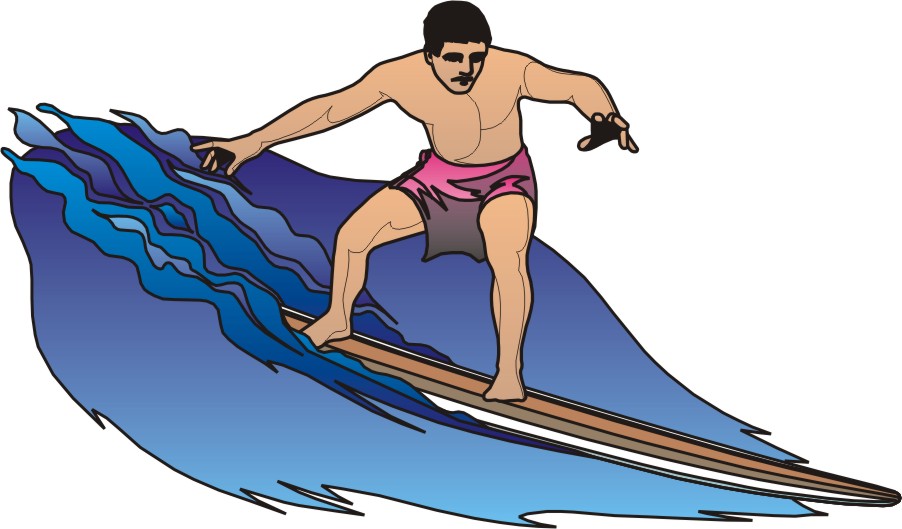The colored graphic illustrating this activity was not part of the original document. The line-drawing graphic was part of the original document. The source page number appears in brackets before the text of that page.
23. Hei-hei-na-lu

[Page 212] The surf-board, pa-pa-hee-na-lu, is made from the wood of the wi-li-wi-li (Erythrina corallodendrum) or bread-fruit tree. Ellis1 describes it as generally five or six feet long, and rather more than a foot wide, sometimes flat, but more frequently slightly convex on both sides. It is usually made of the wood of the Erythrina, stained quite black and preserved with great care. After using, it is placed in the sun until perfectly dry, when it is rubbed over with cocoanut oil, frequently wrapped in cloth, and suspended in some part of the dwelling. Dr Bolton2 describes the play as follows:
"Plunging through the nearer surf, the natives reached the outer line of breakers, and watching their opportunity they lay flat upon the board (the more expert kneeled), and just as a high billow was about to break over them, pushed landward in front of the combers. The waves rushing in were apparently always on the point of submerging the rider, but, unless some mishap occurred, they drove him forward with rapidity on to the beach or into shallow water."
[Page 213] Racing in the surf is called hei-hei-na-lu, from hei-hei, "to race," and na-lu "surf." Two champions will swim out to sea on boards and the one first arriving on shore wins.
Playing in the surf is hee-na-lu from hee " to glide." Andrews gives the names o-lo and o-wi-li for "a very thick surf-board made of wi-li-wi-li", and o-ni-ni as "a kind of surf-board"; also pa- ha as "a name for surf-board," and ki-o-e, the "name of a small surfboard."

According to Brigham3 "Surf-boards were usually made of ko-a, flat with slightly convex surface, rounded at one end, slightly narrowing towards the stem, where it was cut square. Sometimes the pa -pa were made of very light wi-li-wi-li and then were narrow, o-lo. In size they varied from 3 to 18 feet in length and from 8 to 10 inches in breadth, but some of the ancient boards are said to have been 4 fathoms long. The largest in this museum are so heavy that they require two men to move them. The surf riders swam out to sea to the ku-la-na or place where the high rollers follow each other in quick succession, and there mounted a high wave and rode on it until near the beach where the water was smoother; the first one arriving at the hu-a won the race. The riders sometimes raced also to the ku-la-na or starting place. Standing on the boards as they shot in was by no means uncommon. Men and women both took part in this delightful pastime which is now almost a lost art."
Wilkes4 says: "The Kingsmill islanders use a small board in swimming in the surf like that used by the Sandwich Islanders." According to Codrington5, "in the Banks' islands and Torres islands, and no doubt in other groups, they use the surf board, tapa."
1 Vol. IV, p. 369.
2 Journal of American Folk-lore, Vol. IV, p. 21.
3 Preliminary Catalogue, part II, p. 55.
4 Op. cit., Vol. V, p. 100.
5 Op. cit., p. 341.
Last update February 3, 2010